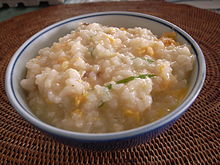Gruel
 Rice gruel | |
| Alternative names | porridge |
|---|---|
| Type | Porridge |
| Serving temperature | Warm |
| Main ingredients | Cereal (oat, wheat or rye flour) or rice, water or milk |
| Variations | Congee |
Gruel is a food consisting of some type of cereal—oat, wheat or rye flour, or rice—boiled in water or milk. It is a thinner version of porridge that may be more often drunk than eaten and may not need to be cooked. Historically, gruel has been a staple of the Western diet, especially for peasants. Gruel is often made from millet, hemp, barley or, in hard times, from chestnut flour or even the less bitter acorns of some oaks.
Though its actual medical use is not proven, the importance of gruel as a form of sustenance has historically been considered for the sick[1] and recently weaned children. Hot malted milk is a form of gruel, although the manufacturers of such products as Ovaltine and Horlicks avoid calling it gruel, owing to the negative associations attached to the word in popular culture, as in Charles Dickens's novel Oliver Twist. From a literary, bourgeois, or modern point of view, gruel has often been associated with poverty. Gruel is also a colloquial expression for any watery or liquidy food of unknown character, e.g., pea soup. The word soup is derived from sop, the slice of bread which was soaked in broth or thin gruel.[2] Gruel was on the Third-Class menu of the Titanic on the eve of her sinking.[3]
History
Gruel was the staple food of the ancient Greeks, for whom roasted meats were the extraordinary feast that followed sacrifice, even among heroes, and "In practice bread was a luxury eaten only in towns". Roman plebeians "ate the staple gruel of classical times, supplemented by oil, the humbler vegetables and salt fish",[4] for gruel could be prepared without access to the communal ovens in which bread was baked. In the Middle Ages the peasant could avoid the tithe exacted, usually in kind, for grain ground by the miller of the landowner's mill by roasting the grains to make them digestible, and grinding small portions in a mortar at home. In lieu of cooking the resulting paste on the hearthstone, it could be simmered in a cauldron with water or, luxuriously, with milk.
In the Americas, maize gruels were once one of the main food sources for many Mesoamerican peoples, such as the Maya and Aztecs. Atole was a preparation of ground maize that was often flavored with chili and salt. It could be consumed or drunk as an important calorie source and as a thirst quencher.
Variations
In many Spanish-speaking countries, several gruels are made; the masa-based drink called atole or atol de elote is a staple throughout Central America, served hot. Common in Mexican restaurants in the U.S., horchata is a chilled sweetened gruel drink made from ground nutmeats or seeds, grains (often rice) and seasonings such as vanilla and cinnamon, served over ice.
Rice gruels eaten throughout Asia are normally referred to as congee from the Tamil word for the food.
Etymology
The Oxford English Dictionary gives an etymology of Middle English gruel from the same word in Old French, both of them deriving from a source in Late Latin: grutellum, a diminutive, as the form of the word demonstrates, possibly from an Old Frankish *grūt, surmised on the basis of a modern cognate grout. In modern Dutch, the plural word "grutten" still refers to de-husked, coarse ground grain. The German "Grissmehl", ground grain, in Dutch "griesmeel", semolina are grist to the English mill.
In fiction

In the English-speaking world, gruel is remembered as the food of the child workhouse inmates in Charles Dickens's Industrial Revolution novel, Oliver Twist (1838); the workhouse was supplied with "an unlimited supply of water" and "small quantities of oatmeal".[5] When Oliver asks the master of the workhouse for some more, he is struck a blow on the head for doing so. The "small saucepan of gruel" waiting upon Ebenezer Scrooge's hob in Dickens's 1843 novel A Christmas Carol emphasizes how miserly Scrooge is. References to gruel in popular culture today continue to refer to miserly or starvation conditions, such as Gemma Collins in Celebrity Big Brother 17 (2016), who was denied food for gruel.[6]
References
- ^ A gruel of cornmeal, soaked and cooking in a double-boiler, was recommended for typhus patients in The American Journal of Nursing 14.4 (January 1914) p. 296.
- ^ Maguelonne Toussaint-Samat, Anthea Bell, tr. The History of Food, revised ed. 2009, p. 161.
- ^ https://www.boredpanda.com/titanic-food-menu-first-second-third-class-passengers/
- ^ Toussaint-Samat 2009, p. 93.
- ^ Oliver Twist, chapter 2.
- ^ There have been many parodies of Oliver Twist; for instance, in The Simpsons episode "Kamp Krusty", Bart and some of the other children are forced to eat "Krusty Brand Imitation Gruel" as their only meal, punctuated by the comment "Nine out of ten orphans can't tell the difference."
